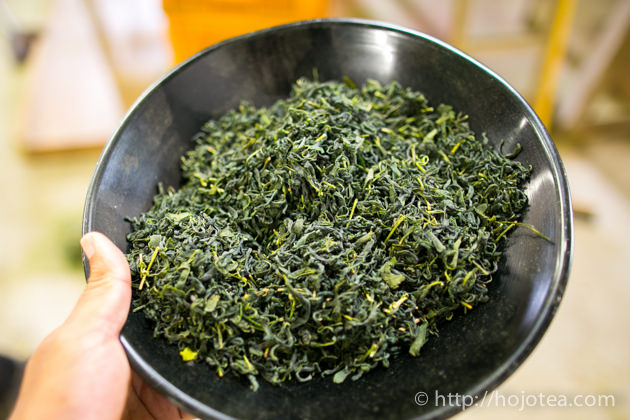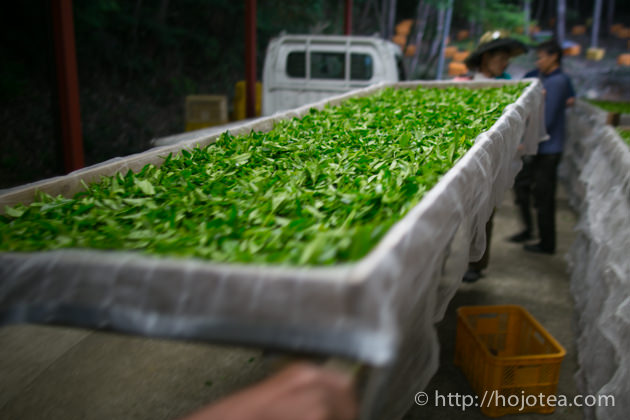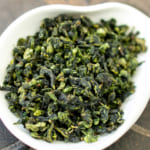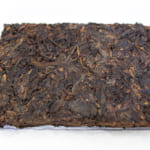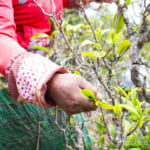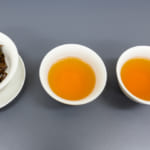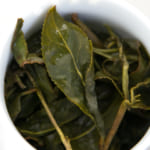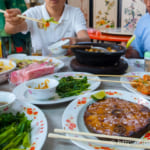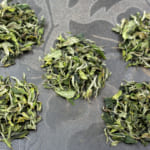- HOME >
- New Arrival at HOJO Online Shop
New Release of Tsukigase Asamomi Sencha 2017

We just released Tsukigase Asamomi Sencha as one of our latest Japanese tea lineups. This tea is produced from the complete natural farming garden which no nitrogen fertilizer and no pesticide is used.
In Japanese, Asamomi means light rolling. Thanks to the light rolling, this tea can be brewed more times than ordinary Japanese green tea. Besides the multi-brewing character, this tea gives distinctive floral scent thanks to the special production method.
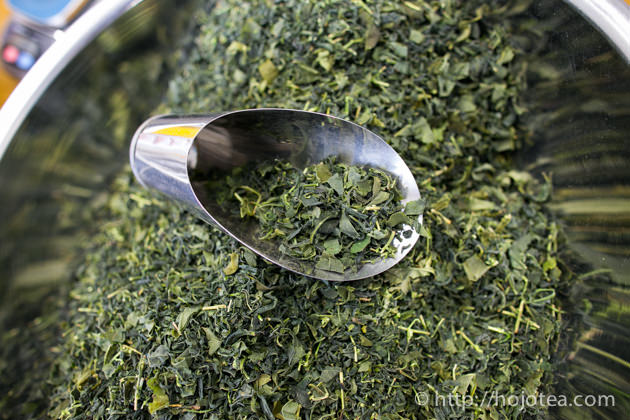
We decided not to make sencha in needle shape
Nowadays, it is undoubtedly that the needle-shape has become the standard of Japanese green tea. Everyone seems to take the needle shape of Japanese green tea for granted. Every Japanese tea manufacturers try very hard always roll tea leaves into needle shape.
In fact, the shape of tea is not related to the taste or flavor of tea. Ironically, the intensive rolling to make tea into the needle shape resulted in tea becomes less lasting in brewing. When brewing Japanese green tea, the 1st brewing tends to be very thick, yet the subsequent brewing often becomes very light. Due to very intensive rolling, the cell of tea leaf was effectively mercerized and the tea constituents were extracted faster.
In other words, we can make Japanese green tea lasts more brewing if we minimize the rolling and swiftly dry the tealeaf right after the steaming process.

Lightly-rolled tea gives fresh floral flavor
For rolling tea leaf into needle shape, it undergoes a few steps of rolling process:
- Preliminary rolling
- Intermediate rolling
- Rolling
- Final Rolling
In fact, these processes are not only rolling the tea leaves but also supplying hot air to dry tea leaves. The temperature of hot air often reaches even up to 100 degree C. As a result, the fresh tealeaf flavor somehow lost during the intensive rolling process.
We drew sample from the each process and taste to understand the changes of flavor. Interestingly, we found that the sample with less rolling gives very refreshing flavor like fresh flower bouquet, while the tea after more rolling gives typical flavor like steamed rice. It seems that this typical steamed rice flavor of Sencha is composed by the heat applied during rolling process.
With this finding, in order to retain as much of the fresh floral note of the green tealeaf, we drastically shorten the rolling process so as to minimize the heat damages to the flavor of the fresh tealeaf.
By the way, the fresh tealeaf scent has its drawback. The fresh tealeaf from the natural farming garden without fertilizer gives floral scent. On the other hand, the fresh tealeaf from the fertilized garden gives very green grassy scent that is rather a less attractive flavor. Since the majority of tea garden in Japan is grown with fertilizers, the intensive rolling process and heating was rather promoted by tea manufacturers as it changes the greenish scent into the flavor like steamed rice.
Since we have carefully selected the garden that uses no fertilizer at all, we wish to rather enhance the floral scent of the fresh tealeaf. Therefore, we use very short steaming time in order to preserve the original flavor of fresh tealeaf.
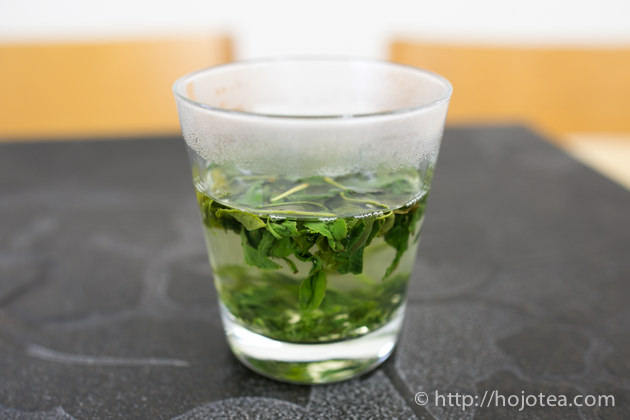
The tealeaf of Tsukigase Asamomi Sencha is quite coarse. It is suitable to brew it directly in a glass. For this drinking style, 2g in 200ml of hot water is ideal.
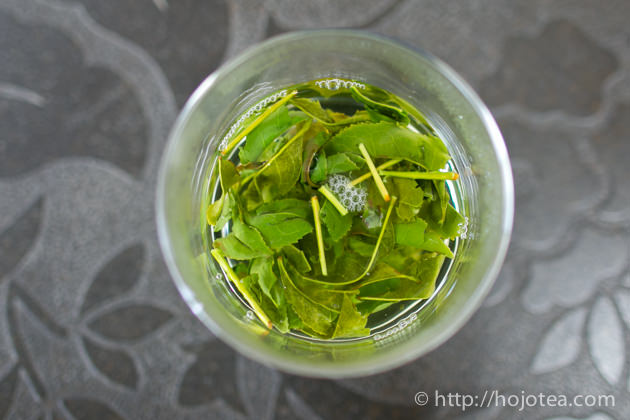
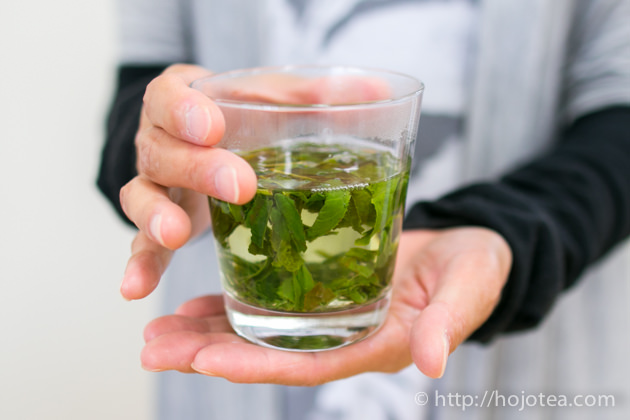
Tea has undergone moderate withering in forest
After the fresh tea leaves were collected, the tea leaves were withered in the forest for 12 hours in order to further enhance the floral scent. However, if the withering is too long, it makes tea into white or oolong tea character. So we requested our manufacturer to carefully determine the precise timing of withering so that it is just nice to enhance the floral scent of this Japanese green tea.
Unique brewing technique
Tsukigase Asamomi Sencha contains very less Umami. Umami is the substance composed by nitrogen derived from fertilizer. Because of these tea trees were grown without nitrogen fertilizer, this Sencha is rather rich in poly phenols and minerals.
Considering this characteristic, the flavor of Tsukigase Asamomi Sencha is more appealing and richer if tea is brewed with boiling hot water for a shorter time.
For the first brewing, I use boiling water and brew for 10-20 seconds. For the second brewing and subsequent brewing, I usually keep brewing time in less than a few seconds.
This tea is also suitable for cold water brewing. For making cold water brewed tea, I suggest 5g of tea leaf soaked in 1 liter of water. You can prepare it in a glass bottle and leave it in a refrigerator for about 4-5 hours. If you prefer a lighter taste, please add in some water to dilute it. It is advisable to use the water cooled down from the boiling water. It gives more flavors.
Related Articles
How to get the latest update on HOJO Tea?
1. Follow Twitter, 2. Click "Like" on Facebook, and 3. Subscribe in newsletter. You can have the latest tea news from HOJO Tea.
 Subscribe the Newsletter to enjoy the privileges
Subscribe the Newsletter to enjoy the privileges- You may receive a free sample upon purchase, or you may have the priority to purchase special products. So please remember to subscribe our newsletter as well as the social network.
- New Release of Lan Yun Tie Guan Yin from Anxi
- Lan Yun Tie Guan Yin from Anxi, is not just an ordinary Tie Guan Yin. It has a strikingly delightful flavor reminiscent of orchid flowers with silky-soft drinking sensation. Anxi, renowned as one of the three major Oolong tea production regions in China. Anxi is recognized as one of the three major Oolong tea-producing regions …
- The new release of Bao Dao Shan Da Cha Tou Brick 2017, exclusively crafted from Da Cha Tou leaves
- Bao Dao Shan Cha Tou Zhuan 2017 is a ripe pu-erh tea crafted into brick form. Bao Dao Shan is the name of the mountain situated in the southwestern part of Yunnan. “Cha Tou” denotes a distinctive type of ripe pu-erh tea. In the course of fermenting spring tea, certain tea clumps naturally develop, known …
NEW ARTICLES
 Yunnan 2024 Spring Tea Sourcing
Yunnan 2024 Spring Tea Sourcing- Yunnan Province is globally renowned for the exceptional quality of its tea leaves. However, lax production management often presents challenges in achieving the desired tea quality when relying solely on pre-made teas. To address this issue, we have committed to remaining on-site throughout the spring season to closely monitor tea production. We are meticulously inspecting …
 The Relationship Between Greenness of Tea Leaves and Fertilizer
The Relationship Between Greenness of Tea Leaves and Fertilizer- For both tea and vegetables, there’s a common misconception that a deeper green colour indicates better quality and greater health benefits. However, this isn’t always the case. Natural plants often have a yellowish-green hue rather than a vibrant green. If you observe wild plants in grasslands or along roadsides during spring, you’ll notice that they …
 Creating Muscatel Black Tea Using a Unique Blending Method
Creating Muscatel Black Tea Using a Unique Blending Method- I would like to introduce the unique creation of black tea with a distinctive muscatel flavor profile. Acquiring Exceptional Mi Xiang Black Tea Have you ever heard of a unique black tea called “Mi Xiang Black Tea” or “Muscatel Black Tea”? This tea is crafted from leaves that have been delicately nibbled by leafhoppers, resulting …
 New Release of Lan Yun Tie Guan Yin from Anxi
New Release of Lan Yun Tie Guan Yin from Anxi- Lan Yun Tie Guan Yin from Anxi, is not just an ordinary Tie Guan Yin. It has a strikingly delightful flavor reminiscent of orchid flowers with silky-soft drinking sensation. Anxi, renowned as one of the three major Oolong tea production regions in China. Anxi is recognized as one of the three major Oolong tea-producing regions …
 The Difference Between Fermentation in Tea and Fermented Foods
The Difference Between Fermentation in Tea and Fermented Foods- Black tea and oolong tea are often categorized as “fermented teas,” but the extent to which they undergo fermentation raises questions about whether they truly qualify as fermented foods. In this article, I endeavour to offer a thorough exploration of the distinctions between tea and traditional fermented foods, shedding light on the nuances of their …
 Easy Way to Prepare Flavorful and Warm Tea at the Workplace
Easy Way to Prepare Flavorful and Warm Tea at the Workplace- Have you ever experienced the transformation of tea stored in a thermos or water bottle at work, turning into a brown hue and acquiring a bitter, astringent taste? As this has piqued the interest of many, I would like to offer a more in-depth explanation for a solution. Tea stored in a thermos undergoes oxidation …
 The new release of Bao Dao Shan Da Cha Tou Brick 2017, exclusively crafted from Da Cha Tou leaves
The new release of Bao Dao Shan Da Cha Tou Brick 2017, exclusively crafted from Da Cha Tou leaves- Bao Dao Shan Cha Tou Zhuan 2017 is a ripe pu-erh tea crafted into brick form. Bao Dao Shan is the name of the mountain situated in the southwestern part of Yunnan. “Cha Tou” denotes a distinctive type of ripe pu-erh tea. In the course of fermenting spring tea, certain tea clumps naturally develop, known …
 We released Lapsang Suchong Qi Zhong Classic: Premium Lapsang Souchong
We released Lapsang Suchong Qi Zhong Classic: Premium Lapsang Souchong- Lapsang Souchong is one of the earliest known black teas distinguished by a unique production method and flavour profile. Its origins are often linked to the Wuyi Mountains in China’s Fujian province, where Lapsang Souchong is traditionally crafted. Black tea production in the Wuyi region has a history dating back several centuries. Lapsang Souchong tea …
 Regular Consumption of Umami Seasoning Can Influence Taste Preferences
Regular Consumption of Umami Seasoning Can Influence Taste Preferences- Excessive consumption of artificial condiments, such as umami seasonings, is believed to influence one’s taste and preferences. I’d like to share my own view to explore how an overabundance of condiments can indeed influence one’s palate. Umami Seasonings Are Prevalent in Asian Countries I spend half of the year living abroad, particularly in China and …
 Special Release Limited Set of Ancient White Tea from 5 Gardens
Special Release Limited Set of Ancient White Tea from 5 Gardens- The ancient white tea is a very popular tea in our store. We produced this tea in spring. Following production, it was stored in an oxygen-free environment for several months to further enhance its flavor, achieving the expected maturation. The production of ancient tree white tea is limited in quantity per day, resulting in small …
Shop Info

Address:Lot No. T-215, 3rd Floor, The Gardens Mall, Mid Valley City, Lingkaran Syed Putra, 59200 Kuala Lumpur
Tel: +603-2287-4537
Business Hour: 10am to 10pm
Category
- New Arrival at HOJO Online Shop
- Featured Articles
- Newsletter
- Types of Tea
- Origin of Tea
- Teapot and Tea Equipment
- Tea Column
- How to enjoy tea
- Tea Processing
- How to choose quality tea
- Tea constituents and functional effect
- Safety of Tea
- Foods
- Tea Business Operation
- Hobby and Outdoor Activity
- Ranking of Tea
- Video
- FAQ
- Media Release
Profile

- AKIRA HOJO
- I invite you to experience my tea selections.I was born in Nagano, Japan. In university, I studied agricultural chemistry, and I have the master degree in food science. I worked in Japanese food industry for 10 years. I involved in R&D, QC and QA. As a factory manager, I implemented ISO9000 series and managed the factory.
- The Art of Tea Magazine
- We posted the article on “The Art of Tea Magazine No.9, the magazine is published in Taiwan. We featured some scientific view about the tetsubin
- New Straits Times
- The Malaysian National Newspaper, New Straits Times featured HOJO Tea on 17-Oct-2007.

